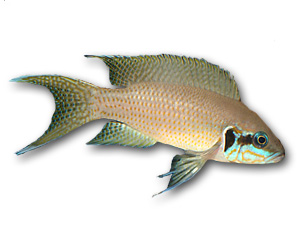Neolamprologus Brichardi

Quick Stats
| Size | Up to 4" (11cm) |
|---|---|
| Tank | 120 litres + |
| Swimming Area | Bottom, middle |
| Ph | 7.5 to 9.0 |
| Temperature | 72ºF to 77ºF(22-26°C) |
| Food | Flaked, pelleted and frozen foods |
Common Name:
Fairy Cichlid Brichardi, Lyretail Cichlid.
Distribution:
Africa, Lake Tanganyika.
Colouration:
A beautiful fish, the base color is tan, with small yellow scales near the start of the tail fin. The tail, dorsal and anal fins are the same as the base color and they are fringed with a blue / white edge, extending along the elongated tips of the tail fin, which really highlight the lyretail. A dark bar runs from the eye, back to the gill cover. A bright gold spot is located just above this bar.
Lifespan:
8 to10 years.
Maintenance:
10 to 20% weekly water changes. Peaceful for a cichlid they should be kept in groups as they will school outside of breeding time.
Feeding:
Feeding is not a problem as they will accept all types of flake and frozen food, in nature they eat small animals.
Substrate:
Crushed Coral Sand. These guys dig!
Tank Decor:
Like all true Tanganyikan set ups the tank should be decorated with a crushed coral or similar substrate and contain lot of rocks that form caves and crevices. This is especially true for the brichardi as a retreat for each fish is a must. The rocks must be firmly anchored as these fish will dig a lot and can disrupt the aquascape and possibly hurt themselves or the aquarium. Provide open areas for swimming. Plants can be used and will not be eaten but should be placed carefully as their digging will continually uproot them.
Filtration:
Provide good filtration and do frequent water changes.
Biotype:
Caves along the rocky bottom, near the shoreline of Lake Tanganika.
Breeding:
One of the easier Lake Tanganyika cichlids to breed, the brichardi is monogamous, meaning that they pair for life. They are cave spawners and will produce around 100 fry per spawn. Excellent parents they will tend to their young for months and will take care of several spawns at the same time. If the tank becomes overcrowded with fry the parents recognize this and won't lay so many eggs on the next spawn or rarely they will eat their young to make room for the next batch. They fry are small and grow slowly but will do well if fed baby brine shrimp and finely crushed flake food.